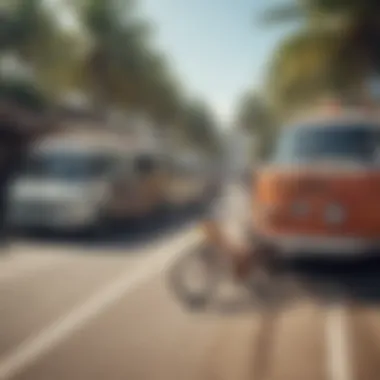Understanding Upcycling: Waste to Resource Transformation


Intro
Upcycling stands as a beacon of hope in today’s world, where waste often seems insurmountable. It represents a shift in how we think about discarded materials and offers a practical way to turn what is often seen as trash into treasure. This revolutionary approach not only contributes to a healthier planet but also sparks creativity and innovation. In this article, we will explore the ins and outs of upcycling, define its significance in the broader realm of sustainability, and provide practical insights into techniques and applications that resonate with surfers, instructors, and eco-enthusiasts alike.
The Essence of Upcycling
Unlike recycling, which breaks things down to create new materials, upcycling emphasizes retaining the original item’s essence while still producing something useful, artistic, or functional. This method aligns with the motto "waste not, want not", as it encourages conscious consumption and resourcefulness. Imagine transforming an old surfboard that’s seen its last wave into a stylish planter for your porch or perhaps a unique piece of wall art.
"Upcycling is not just a trend; it’s a shift towards valuing what we have and using it in innovative ways."
The Importance of Upcycling in Sustainability
With environmental concerns front and center, upcycling presents an effective method for mitigating waste and promoting sustainability. It fosters a culture of innovation, reducing the strain on our planet’s resources. For instance, surfers can embrace this movement by converting used surf gear into new products, like fins or leashes, keeping more plastic out of landfills and oceans. Such practices not only help protect marine ecosystems but also cultivate a deeper connection to the nature of surfing.
Upcycling vs. Recycling
The distinction between upcycling and recycling is subtle yet crucial. While both aim to minimize waste, recycling involves processing worn materials into new ones, often losing their original identity in the process. Upcycling, on the other hand, is about enhancement and transformation. This key difference opens doors for creativity and practical applications in daily life. Many DIY enthusiasts take upcycling to heart, using items that others might overlook and turning them into sought-after pieces.
Surfboarding Techniques
Beginner Tips for Mastering the Basics
As a beginner surfer, there’s much to learn, and it requires not just practice but also a sustainable mindset. Start by familiarizing yourself with eco-friendly surfboards made from recycled materials, like those from companies that prioritize environmental consciousness. Practicing on a soft top board can help ease your entry to the water. These boards are generally more forgiving and suited for learning.
- Choose the right surfboard: Opt for a board that suits your weight and height.
- Learn the paddling technique: Efficient paddling conserves energy and helps you catch more waves.
- Practice balance: Spend time on land practicing your stance to build muscle memory.
Advanced Techniques for Seasoned Surfers
Once you’ve got the basics down, advanced techniques await. Experienced surfers often explore using upcycled materials in their gear, optimizing performance while contributing to sustainability. Mastering maneuvers like cutbacks or aerials can be enhanced with lightweight, custom upcycled boards, providing both performance and eco-friendliness.
- Cutbacks: This maneuver helps maintain your speed while returning to the pocket of the wave.
- Aerials: These high-flying tricks require a combination of speed and agility, great for more experienced riders.
Using upcycled or sustainably sourced equipment from retailers committed to environmental standards not only amplifies your surfing experience but also positions you as a steward of the ocean.
The End
Upcycling is more than just a creative outlet; it's a necessary evolution in how we perceive waste and our relationship with the environment. By embracing upcycling within surf culture, we can engage in a lifestyle that prioritizes sustainability while continuing to enjoy the sport we love. Those who dive into this movement position themselves not only as surfers but also as advocates for change, ensuring that our oceans remain pristine for generations to come.
Defining Upcycling
To embark on our journey into upcycling, we first need to clearly define what this practice is all about. Upcycling isn't simply tossing a used item into a recycling bin; it’s about taking what’s considered waste and finding a new purpose for it. The core essence of upcycling lies in its transformative nature, wherein discarded materials are repurposed into something of higher value or quality. It’s not just a trend, but rather a mindset that resonates deeply with environmental sustainability and creativity.
The importance of understanding upcycling can’t be overstated. It serves as a direct counter to the conventional throwaway culture that has permeated modern society. By rediscovering the potential in items we may no longer use, upcycling not only reduces waste but also inspires innovation. For individuals and communities alike, it encourages a more responsible approach toward consumption and disposal, fostering a deeper appreciation for resources we often take for granted.
Origins of Upcycling
The term "upcycling" first made its rounds in the late 1990s, particularly popularized by designer Reiner Pilz. While we've always seen people reusing or transforming items, formalized creative efforts to elevate discarded goods began to take shape during this time. Historically, when resources were scarce, upcycling was merely a survival mechanism. Not long ago, folks would patch up clothes or give new life to furniture rather than tossing it aside.
Today, we see a resurgence of upcycling, largely driven by the rise of environmental consciousness. From DIY enthusiasts sprucing up flea market finds to companies producing high-end fashion from used textiles, the origins of this practice have reached widespread mainstream appeal. As we look back, it quickly becomes evident how upcycling bridges the gap between our past and present consumption habits, encouraging a full circle of sustainability.
Differences Between Upcycling and Recycling
Understanding the differences between upcycling and recycling is crucial for grasping the broader topic of waste management.
Upcycling can be described as a creative reuse of materials. It repurposes items into something new and often more valuable without breaking them down into their original form. Think of a surfboard chair made from an old surfboard. A simple yet effective transformation that not only saves material but also tells a story.
On the other hand, recycling typically involves a process where materials are collected, broken down, and recreated into new products. An example of this is smashing up glass bottles to form new glass items. While recycling is indispensable in reducing landfill waste, it often loses the unique essence of the original material during the transformation.


Here’s a summarization for clarity:
- Upcycling:
- Recycling:
- Transforms waste into higher-value items.
- Maintains the original material's identity.
- Emphasizes creativity and innovation.
- Processes materials to create new products.
- May lose the original characteristics of the material.
- Typically more standardized in its approach.
"Upcycling is not just about waste management; it's about redefining our relationship with materials and encouraging creativity in unexpected ways."
The Importance of Upcycling
Upcycling serves as a beacon of hope in a world drenched in waste and environmental degradation. It brings to the forefront the idea that what we often consider trash has immense potential when viewed through a different lens. The importance of upcycling cannot be overstated; it transcends mere environmental benefits, spilling over into economic, social, and even cultural spheres.
The practice is gaining traction and becoming an intrinsic part of the sustainability narrative. This push is vital, especially in light of the overwhelming statistics regarding landfill overflow and plastic pollution. More than just a trend, it represents a shift in mindset towards valuing resources and acknowledging their lifecycle.
Environmental Impact
The ecological implications of upcycling are profound. By transforming waste into usable materials and products, upcycling helps to lower the demand for virgin resources. This, in turn, curbs deforestation, mining, and the incessant extraction of materials that often harm our planet. Furthermore, it keeps waste out of landfills, reducing harmful emissions from decomposing organic matter.
As per recent studies, an estimated 75% of waste generated could be diverted through better practices, including upcycling. It's not just about reducing, reusing, and recycling anymore; it’s about thinking creatively and innovating, which leads to a more sustainable future.
"Every act of upcycling is a small, yet significant rebellion against consumer culture and wastefulness."
The importance of upcycling also extends to preserving energy. The energy credits one can save by upcycling are staggering. For instance, producing new items from recycled materials typically consumes less energy than fabricating new products from raw stock. Reducing energy consumption not only helps the planet but also curtails costs in manufacturing.
Economic Benefits
It's essential to recognize how upcycling can contribute economically. One of the simplest ways is through job creation. As more businesses embrace the principles of upcycling, the need for skilled artisans and craftspeople rises, leading to potential employment opportunities. Small businesses thrive on creativity, and upcycling offers a unique angle that is both niche and marketable.
Small-scale upcycling operations have emerged, creating products ranging from furniture crafted from reclaimed wood to fashionable attire made from discarded fabric. This not only incentivizes entrepreneurship but also satisfies an increasing consumer demand for sustainable goods.
Moreover, upcycling can serve to elevate a brand. In today’s market, consumers are diligent about where they spend their money. Supporting upcycled goods resonates strongly with eco-conscious shoppers, often willing to pay a premium for products rooted in sustainability. They want to align their personal values with their purchasing habits.
In summary, the importance of upcycling stretches beyond mere environmental responsibility. It embodies innovation, economic growth, and an affirmation of creative potential. As individuals and communities consciously embrace these practices, they can expect their relationship with waste to evolve, turning what was once seen as trash into treasures of immense value.
Techniques of Upcycling
Understanding the techniques of upcycling is critical in transforming waste into valuable resources. This section delves into several approaches that highlight creativity, practicality, and the potential for sustainable living. In an age where environmental issues take center stage, these techniques prove to be more than just a trend; they’re essential practices that encourage a circular economy and inspire community resilience.
Repurposing Materials
Repurposing materials is at the heart of upcycling. This technique involves taking old products or byproducts and giving them a new function without significantly altering their original form. Picture this: an old wooden pallet that once transported goods can become a rustic coffee table with minimal modifications. Such transformations not only save resources but also tell a story of sustainability and creativity.
There are multiple benefits to this approach:
- Reduced Waste: By repurposing items, landfills see less waste. Instead of tossing out an unused item, it gets a second life.
- Cost-Effective: Budget-conscious individuals or organizations save money by sourcing materials from waste instead of purchasing new ones.
- Unique Creations: Each repurposed product tends to have character. This uniqueness often captures attention, especially in communities that value handmade or one-of-a-kind goods.
Engaging in repurposing can also foster a sense of community, as local artisans and makers explore creative possibilities together. The buzz around repurposing spreads awareness and sparks conversations about sustainability.
DIY Projects
Diving into DIY projects is another fantastic way to engage with upcycling. For many, the thrill of creating something new from what’s regarded as waste is unlike any other. From turning glass jars into chic storage solutions to sewing old t-shirts into reusable shopping bags, the options are vast. Here are a few pointers that can help enthusiasts venturing into DIY upcycling:
- Start Small: Beginners might find it helpful to start with smaller items to gain confidence and skills.
- Research and Explore: There’s a wealth of inspiration available online, from Pinterest boards to dedicated upcycling forums on Reddit.
- Use Local Resources: Thrift stores and donation centers can become treasure troves for materials. Surf shops, for instance, often discard unsellable items that can be repurposed creatively.
Involving families and friends in DIY upcycling projects fosters teamwork and strengthens bonds, all while promoting eco-friendly practices. It’s an opportunity to share skills, ideas, and inspiration, turning individual endeavors into collective movements.
Artistic Expressions Through Upcycling


Art is perhaps one of the most visible realms where upcycling has gained traction. Artists around the globe are incorporating discarded materials into their work, transforming waste into powerful statements about consumption and sustainability. This method gives rise to art that not only captures aesthetics but also conveys deeper meanings about environmental consciousness.
- Sculptures and Installations: Artists often create captivating sculptures from salvaged scraps, making bold statements about the disposability of modern life. These pieces can provoke thought and inspire change.
- Functional Art: Many creators design furniture or home decor from upcycled materials. Consider a lamp made from an old surfboard, blending functionality and artistry seamlessly.
- Community Art Projects: Local initiatives can focus on uplifting communities. Collecting waste together to create public artworks can enhance community spirit and spread awareness about environmental issues effectively.
"Art is not a thing; it is a way." – Elbert Hubbard
Engaging with artistic expressions through upcycling not only leads to vibrant creations but also develops a narrative around the materials used. Such projects can serve as reminders of the importance of rethinking consumption habits and understanding the value of every item, no matter how worn out it may seem.
Upcycling in the Surfing Community
The connection between surfing and environmental responsibility is more crucial than ever. As the sport thrives on pristine beaches and clean oceans, there’s a growing consciousness among surfers about the impact of their activities on the environment. Upcycling presents a unique avenue for those in the surfing community to turn the tide against waste, converting discarded materials into innovative and eco-friendly products. This approach not only contributes to sustainability but also cultivates a culture that values creativity and ingenuity.
Upcycling in the surfing community embodies not just a trend, but a movement towards a more mindful approach to the ocean and its resources. Surfers are increasingly acknowledging that every piece of plastic pollution or foam waste can be transformed into something valuable—be it for personal use or commercial products. By championing this practice, surfers help to forge a closer bond between their passion and the environment, fostering responsible stewardship of the natural world.
Sustainable Surfboards
When discussing sustainable surfboards, it’s important to recognize the vast array of materials and methods that can redefine how these vital pieces of equipment are made. Traditionally, surfboards are crafted from materials that are harmful to the environment, including polystyrene foam and polyurethane resin. However, an upswing in the use of recycled or upcycled materials is evident in the industry.
Companies like Firewire Surfboards and NSP have begun integrating recycled plastics, like those sourced from discarded fishing nets or ocean waste. This not only reduces the consumption of new resources but also supports the cleaning of our oceans. Moreover, certain brands are experimenting with bio-resins, which are derived from renewable resources and offer a less toxic alternative to traditional resins.
Some intriguing innovations include surfboards made from upcycled materials that were previously deemed waste, such as old surfboards themselves or other plastics collected from beaches. These processes not only help minimize waste but provide surfers with unique boards that have their own stories and character.
Upcycled Surf Accessories
Upcycling isn't limited to surfboards; it also extends to a wide range of surf accessories. From leashes and surf bags to wax and fins, there’s a growing trend among artisans and brands to repurpose materials that would typically fill landfills.
For instance, some eco-conscious brands create surf leashes from upcycled fishing line, ensuring a durable yet environmentally friendly product. Moreover, surf bags crafted from recycled sails or wetsuits are not only practical but also embody a story of conservation and creativity.
"By embracing upcycling, surfers take a proactive stance in cleaning our oceans. It’s not just about the ride anymore; it’s about preserving the waves for future generations."
Each accessory serves as a statement, not just about style, but about the wearer's commitment to sustainability. The aesthetic appeal of products born from upcycling is undeniable—these items often represent a blend of unique designs and practical functionality.
As this movement continues to gain traction, it's worth noting that it goes beyond just creating products. Engaging in upcycling activities fosters a sense of community among surfers who share a passion for both the sport and the planet. Workshops and collaboration initiatives encourage creativity and build awareness regarding marine conservation.
Through their dedication to upcycling, surfers contribute vital narratives that inspire others outside the community. This push toward sustainable practices resonates far beyond the ocean—it invites everyone to consider their own impact and rethink their relationship with waste. By weaving upcycling into the very fabric of surfing culture, enthusiasts make waves of change that echo both on the beach and in the waves themselves.
Challenges in Upcycling
Upcycling, while a commendable initiative toward sustainability and creativity, is not without its hurdles. Understanding these challenges is vital for those looking to dive deeper into upcycling practices, especially for community members like surfers and eco-enthusiasts who desire to foster a sustainable lifestyle. Exploring the obstacles associated with upcycling can enhance the effectiveness and acceptance of these practices.
Quality Control Issues
One of the most pronounced challenges in upcycling is managing quality control. When salvaged materials are transformed into new products, maintaining a consistent quality is a critical concern. Unlike traditional manufacturing, where processes are regulated and raw materials are standardized, upcycled products often come from diverse sources and varying conditions. This can lead to disparities in the durability and safety of the final products.
- Limited Regulation: Many upcycled products are created by individual artisans or small businesses who may lack the resources to adhere to stringent quality standards. This variance can result in a mixed bag of outputs, potentially confusing consumers about what to expect regarding durability and functionality.
- Material Integrity: Items deemed suitable for upcycling may have hidden defects or be made from materials that degrade over time or with use. For instance, old metal or wood can harbor structural weaknesses that aren’t apparent upon initial inspection.
To overcome these issues, it’s crucial for upcyclers to adopt best practices in their processes. This can include thorough inspections of materials, testing products for quality before sale, and even promoting transparency about how items were created.
Consumer Perception
Another significant aspect that affects the growth of upcycling is consumer perception. Many consumers are still trapped in a mindset that equates quality with brand-new items, often viewing upcycled goods with skepticism. This perception can hinder the marketability of upcycled products, leading to questions about their efficacy, hygiene, and style.
- Luxury vs. Necessity: For some, upcycled items are seen as less desirable because they are not brand-new. Until the stigma surrounding second-hand materials is eradicated, it's tough to convince a broader audience of their value.
- Educational Gaps: There is often a lack of understanding about what upcycling truly involves. Many people are unfamiliar with the creativity and skill that can go into transforming waste into beautiful, functional items. Here lies an opportunity for those in the upcycling community: as education efforts increase around the benefits and potential of upcycled goods, so too can community buying habits shift.
"Upcycling is not just about reducing waste; it’s about recognizing the inherent value in materials we often overlook."
To tackle these perception issues, highlighting stories behind upcycled products can greatly help. By sharing the journey of these materials and the innovation behind each item, consumers may develop a more favorable view that embraces sustainability and creativity.
Promoting Upcycling Practices


Promoting upcycling practices is essential not only for environmental sustainability but also for encouraging a shift in our consumer culture. Upcycling goes beyond just recycling; it promotes a philosophy of valuing products and resources, extending their lifespan in creative ways. As we face increasing threats from pollution and waste, it becomes critical to foster an awareness of how reimagining what we consider waste can induce a positive impact.
Community Initiatives
Community initiatives serve as the backbone of promoting upcycling practices. Local groups can set the stage for change by organizing workshops or events that encourage individuals to think outside the box. Examples might include a neighborhood upcycling market where people can trade or sell their creatively transformed items. These gatherings not only showcase the skills within the community, but they also provide an avenue for newcomers to learn from seasoned upcyclers.
Below are some specific community initiatives that can enhance upcycling practices:
- Workshops: Regular workshops that teach practical skills, such as sewing, woodworking, or crafting from discarded items.
- Collaborative Projects: Undertaking large-scale projects, like transforming a community park or space with upcycled materials.
- Awareness Campaigns: Using social media platforms (like Facebook and Reddit) to spread the message, connect with others, and organize local efforts.
Engaging with these initiatives not only fosters a sense of community but also normalizes the practice of upcycling among various demographic groups.
"Upcycling fosters creativity, reduces waste, and strengthens community ties—three significant benefits wrapped into one practice."
Education and Awareness
Building a foundation for effective upcycling practices fundamentally relies on education and awareness. Many people may not fully understand what upcycling is or its benefits. Institutions, community leaders, and influencers can make significant strides by stepping up to fill this knowledge gap. Teaching individuals about the advantages—both environmental and economic—of upcycling elevates the practice from a niche idea to a mainstream concept.
Key aspects of education and awareness might include:
- School Programs: Integrating upcycling themes into school curriculums can imbue children with environmental consciousness from a young age. Projects could include homemade art from recyclable materials, emphasizing creativity.
- Online Resources: Providing access to tutorials, articles, and videos highlighting successful upcycling projects can inspire the wider community. Websites like Wikipedia or Britannica can serve as platforms to share beneficial information.
- Local Engagement: Organizing community talks or presentations that highlight local upcycling success stories can motivate others within the same community.
Raising awareness and educating about upcycling enables individuals not only to participate but to feel empowered in contributing to a more sustainable future. As more people become advocates for upcycling, the collective momentum can catalyze a shift towards responsible practices.
By integrating community initiatives and education, we can create a culture that regards waste not as rubbish but as a potential resource, cherished for what it can become.
Future of Upcycling
As we peer into the horizon of sustainability, the future of upcycling stands as a beacon for individuals and communities alike. Its essence captures not just the transformation of waste into useful products, but also sparks a much broader conversation about resourcefulness and innovation in society. With rising concerns over waste management and climate change, upcycling offers a practical approach that fits neatly with a circular economy and enhances our ecological footprint.
Technological Advances
The world of technology is stirring things up. New advancements offer exciting opportunities for upcycling to go mainstream. For instance, techniques like 3D printing are changing the game by allowing creators to transform discarded materials into astonishingly unique products. Imagine turning plastic bottles into custom phone cases or furniture parts through additive manufacturing. It blurs the line between waste and resource, urging us to rethink what we consider trash.
Moreover, advancements in artificial intelligence are improving the sorting processes of materials. AI-driven machines can efficiently separate recyclable waste from non-recyclable; this not only boosts upcycling potential but also reduces contamination in recyclable streams. Think about it: With better sorting technology, more materials become available for creative use, leading to a richer array of options for upcycled products.
Integration Into Mainstream Practices
Embracing upcycling as a mainstream practice is no longer a wild dream, but rather an achievable reality. Businesses increasingly harness consumer interest in sustainability. Companies like Patagonia are already demonstrating this by incorporating recycled and upcycled materials into their product lines, showing that good things can come from what we once deemed waste.
There’s a growing community of makers and influencers who celebrate upcycling, filling our social media feeds with inspiration. They share tutorials, showcase their DIY projects, and foster awareness about the benefits of upcycling. It spreads like wildfire, encouraging others to join the movement. This shift in consumer behavior means businesses must pay attention; sustainability isn’t just a buzzword anymore, it’s becoming a mandate.
As the surfing community embraces eco-conscious practices, shops, and brands associated with this lifestyle are likely to leap onto the upcycling bandwagon, offering surfboards made from reclaimed materials or accessories fashioned from discarded gear. It's a culture ripe for this transition, where every surf session can double as an act of environmental stewardship.
Key Takeaway: The future of upcycling will not just involve isolated efforts but will weave itself into the very fabric of our daily lives. Whether it's through technological advances that lower barriers or an industry-wide embrace, upcycling is set to redefine waste management in a society increasingly focused on sustainability.
End
The conclusion in this article holds significant weight, acting as a bookend to the discussion on upcycling and its impact on both individuals and communities. It stitches together the various threads explored throughout the piece, reaffirming the benefits of adopting upcycling practices while extending an invitation to embrace responsibility for our environmental footprint.
Recap of Upcycling Benefits
Upcycling stands as a powerful remedy to the challenges of waste management. Not only does it aim to reduce landfill overflow, but it also breathes new life into items that might otherwise be discarded. Here are some key benefits to consider:
- Environmental Preservation: By reducing the amount of waste heading to landfills, upcycling actively contributes to environmental conservation. Less waste translates to fewer greenhouse gas emissions and a decreased need for new raw materials.
- Creative Expression: Upcycling encourages creativity, as individuals and communities find innovative ways to transform items. This can lead to unique products that showcase personal style and values.
- Economic Opportunities: Engaging in upcycling can foster micro-enterprise ventures, allowing crafters to sell their upcycled items, thus contributing positively to the local economy.
- Sustainable Living: By prioritizing the reuse of materials, upcycling becomes a cornerstone of sustainable living, promoting healthier consumption patterns and less reliance on disposable goods.
Thinking through these benefits provides a clearer understanding of why upcycling is not merely a trend but a movement toward a more sustainable future.
Call to Action for the Surfing Community
For the surfing community, the concept of upcycling can resonate deeply given the unique relationship between surfers and the oceans they cherish. It's essential for surfers, instructors, and eco-conscious adventurers to not only advocate for but also actively participate in upcycling practices. Here’s how the surfing community can take action:
- Support Local Brands: Seek out surfboard manufacturers that prioritize sustainable practices and utilize upcycled materials in their products. Supporting companies like Firewire Surfboards and others dedicated to sustainability can make a direct impact.
- Participate in Clean-Up Initiatives: Engage in community clean-up projects where discarded materials can be transformed into surf gear or art installations. This not only beautifies the coastline but also raises awareness about marine debris.
- Host Workshops: Encourage local surf shops to host workshops where instructors and surfers can learn about upcycling techniques. This interaction not only builds community but also educates participants on sustainability.
- Share Stories and Practices: Use social media platforms like Facebook and Reddit to share your upcycling projects, inspiring others to join the cause. Documenting the transformation of waste into surf-related creations showcases the creativity within the surfing culture.
By committing to these practices, the surfing community can lead by example, showing that preserving the beauty of the oceans and promoting sustainable living go hand in hand. A united effort can catalyze significant change, helping to protect the very environment that surfers dedicate their lives to enjoying.















